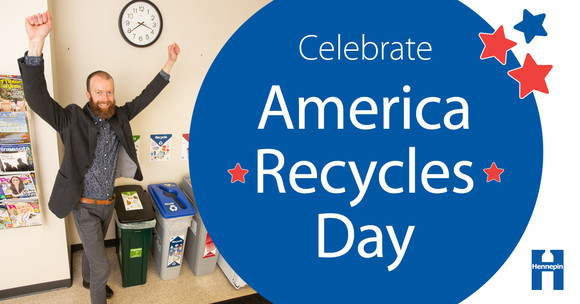
On November 15, we celebrated America Recycles Day – a day to recognize the impact recycling can have and refresh your knowledge of what you can recycle.
When it comes to recycling, it’s easy to get confused by the details. But you can have a big impact by focusing on the basics.
Here are 5 tips on what you should always recycle at home, how to recycle correctly, and why it matters.
-
Paper: Surprisingly, there’s a lot of room for improvement with paper recycling. Always recycle mail, newspapers, magazines, catalogs, and school and office papers. Include window envelopes and glossy paper, but remove any plastic inserts.
-
Boxes: Boxes have become an increasingly large part of our recycling stream. Always recycle delivery boxes, cardboard boxes, cereal and cracker boxes, and boxes from toiletries. Take everything out, and collapse boxes before recycling.
-
Plastics: Plastics are the most confusing category and generate the most questions. Focus on recycling plastic bottle and jugs; containers for things like yogurt, cottage cheese, margarine, and produce; and clear cups. Empty and rinse before recycling, and leave plastic caps on.
-
Resin codes: People often ask about the number on plastic items. Despite appearances, this number tells you the type of plastic the item is but not if it recyclable. As a general rule of thumb, stick to recycling plastic bottles, jugs, cups, and containers that have a resin code number 1, 2, or 5, and avoid recycling plastics 3, 4, 6, or 7.
-
Metal: Metal is one of the most valuable recyclable items because metal recycling is fast and efficient. The recycling rate for metal cans could be higher, so make it a habit to always recycle metal cans no matter where you are.
Recycling is important – it saves energy, conserves natural resources, and supports our local and regional economy – so keep it up and use our tips to enhance what you are already doing at home.
Get answers to your recycling questions
If you’re not sure if something is recyclable, find out! We’re here to answer all of your recycling questions – reach out on social media (Hennepin Environment on Facebook and @hennepinenviro on Twitter) or email us at environment@hennepin.us.
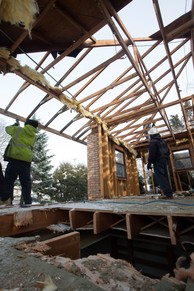
In an effort to divert waste from landfills, Hennepin County will begin providing incentives to homeowners and developers to deconstruct structures rather than demolish them.
Big opportunities to reuse and recycle building materials
Deconstruction involves carefully dismantling buildings to salvage materials for reuse. Commonly salvaged building materials include old growth lumber, doors, flooring, cabinets and fixtures. Only 30 percent of the construction and demolition waste generated in the Twin Cities metro area is currently diverted for recycling. Deconstruction provides an opportunity to divert up to 85 percent of construction and demolition waste and provides numerous environmental and social benefits compared to standard demolition.
Compared to standard demolition techniques that use mechanical equipment to knock down structures, the additional labor costs and time with deconstruction can be a deterrent. The newly established incentive program will help make deconstruction a more affordable option by offering up to $5,000 to homeowners and developers for deconstruction projects. Starting in 2020, the program will initially be implemented in Minneapolis and St. Louis Park, but additional cities will be recruited for participation as the program expands.
Additional efforts to divert construction and demolition waste from landfills
The new incentive fund is part of a broader strategy to divert construction and demolition waste from the trash. Other efforts include encouraging deconstruction practices in county demolition projects, assuring proper disposal of hazardous materials by demolition contractors, and promoting opportunities to reuse building materials to builders and residents.
For more information, contact Carolyn Collopy at carolyn.collopy@hennepin.us or 612-596-0993.
|
Hennepin County is no longer accepting non-reusable clothing and textiles at the county’s drop-off facilities. The program is being discontinued because the county has not been able to find a vendor that can verify the material is being recycled.
What to do with clothing and textiles
First, think about how you can reduce textile waste.
- Before you buy something, consider if you really need the item, if you can buy it used, or if you could rent it or borrow it instead.
- When you buy, invest in high-quality and durable goods, and avoid trendy, cheaply made, or intentionally disposable items.
- After you buy, take good care of your items to extend their life, repair tears and holes (you can get mending help at a Fix-It Clinic), and consider creative ways to repurpose items. For example, worn out or stained textiles can be repurposed as rags or stuffing for pillows.
When you’re ready to get rid of an item, seek out donation options. Check with organizations before donating as the condition that used items must be varies. Find a donation options near you on the Choose to Reuse website. As a last resort, clothing and textiles can go into the garbage.
Diversifying the urban forest
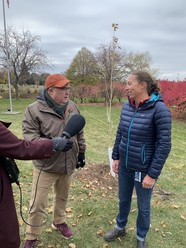
In a recent interview on MPR, Hennepin County forester Jen Kullgren discussed the importance of diversifying the county’s tree canopy. MPR host Tom Crann visited Trillium Park in St. Anthony where county foresters and community volunteers recently planted more than 20 different species of trees. These trees were planted to replace ash trees that have been proactively removed before they become infested with emerald ash borer.
Kullgren explained that ash trees, a hardy and relatively fast-growing urban tree, were commonly planted in the 1970s and ’80s to replace elm trees that had died from Dutch Elm Disease. The trees were a good choice at the time because they can grow in challenging locations and there weren't as many concerns about tree pests. But an increasingly global economy means that potential pests and diseases spread more easily around the world.
A key focus now is to diversify the urban forest so that future tree pests or diseases only impact a few trees in an area rather than needing to remove entire blocks of trees at once. This approach presents the opportunity to plant some unique trees, including Turkish Hazelnut, Kentucky Coffeetrees, and elm trees that are resistant to Dutch Elm Disease.
|
Personal experiences and connections help expand participation in organics recycling
Four years into organics recycling service being available throughout Minneapolis, the big surge in signups for the program are starting to level off, making personal stories and connections an increasingly important way to get more people to participate. This is why Hennepin County awarded grants to community organizations to conduct peer-to-peer outreach on organics recycling.

As part of their grant, the Tangletown Neighborhood Association hosted a tour of the compost site in Rosemount where the materials collected in the organics recycling program are delivered. Most of the people on the tour already participate in the organics recycling program, but seeing the process firsthand helps make them champions for the program who now have personal insights to share with their networks.
Even having conversations can make a difference. As part of required research for the grant, Sally Bauer, the leader of the Tangletown grant, had a conversation with her mother about why she hadn’t signed up for organics recycling. That conversation led to additional conversations and an eventual new sign up in the program. This type of outreach requires time and persistence, but it makes a big difference in continuing to grow a program over time. Read more in the Southwest Journal.
|
Workshop provides educators hands-on lessons in tree and nature education

On November 2, 25 teachers and environmental educators gathered at Eastman Nature Center to learn new tree-related curriculum in Project Learning Tree. The training, led by Hennepin County forester Jen Kullgren and Como Zoo educator Alexa Swan, incorporated indoor and outdoor learning activities to encourage environmental awareness and appreciation for trees. Many participants were excited to take the curriculum back to their schools and take more students outside. Watch a recap of the training on CCX media.
|
Incorporate sustainability into the holidays by focusing a few actions
It’s that time of year – string lights are blinking, trees lots are popping up, and menorahs are on sale. The holiday season often contains a substantial amount of consumption and waste for many Americans. So making low waste and sustainable choices during the holiday season is a lofty and sometimes daunting goal.
If you want to incorporate sustainability into your upcoming holiday season, try picking one or two ways to enact personal change. Focusing on a few actions will set you up for success and build momentum for future change.
Shopping decisions you can make now that will minimize waste later
Planning ahead is an important part of sustainability during the holidays – many shopping decisions made early in the season have a big impact on what you’ll need to dispose of after the holidays.
Here are a few shopping and disposal tips for commonly asked about items during the holiday season:
Cards
When purchasing cards, buy or order cards printed on recycled-content paper, consider using a postcard to reduce paper use and avoid envelopes, and opt for cards that are plain paper so they can be recycled.
Cards that have glitter, foil, or plastic pieces or cards printed on photo paper cannot be recycled. Any cards that make sounds or light up have a battery that should be removed and recycled – batteries are accepted at Hennepin County drop-off facilities.
Gift wrap
Wrapping paper is problematic in the recycling process. A lot of it contains glitter, foil, or plastic and it may be covered in bows or ribbons – all of which makes it not recyclable.

Balled up wrapping paper is also an issue. Recycling sorting facilities are set up to sort flat or slightly crunched up paper, so balls of paper likely won’t get sorted correctly.
There are a lot of good alternatives to wrapping paper, including gift bags, cloth wrapping, and decorative reusable boxes. If you do use paper to wrap gifts, use plain paper, avoid anything with glitter, foil, or plastic, and flatten it before recycling.
|
Trees
Shop at thrift stores for artificial trees – many locations stock up on these this time of year (which also means it’s a good time to donate anything you no longer use).
For real trees, visit a nursery or farm that supports organic and sustainable growing or harvesting practices. After the holidays, check with your hauler or city to see if they offer special pickup options or bring trees to a yard waste site.
String lights

String lights and cords cannot go in your recycling at home because they get tangled in the equipment at recycling sorting facilities. But they are accepted for recycling at Hennepin County drop-off facilities.
|
Décor
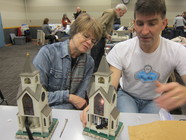
It’s a bummer when your favorite light up Christmas tree or musical carolers display stopped working, but there’s a good chance you can fix it! Visit the next Fix-It Clinic on Saturday, December 14 from noon to 4 at the Maple Grove Community Center to get free, guided assistance from handy volunteers.
If you’re shopping for décor to make your home more festive, visit a local thrift store. Many of them have a great selection of holiday decorations for a fraction of the price.
|
Disposable plates, cups, utensils, and napkins
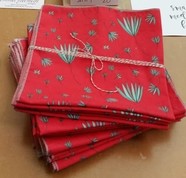
It’s so tempting to purchase disposable plates, cups, utensils, or napkins with cute holiday and winter designs, and it seems like they’ll make your holiday party much simpler and convenient. But most of this stuff is not recyclable or compostable (unless you choose certified compostable products and have organics recycling), and you still have to deal with all that extra trash.
For many families, holiday party dishwashing becomes a fun tradition or game. And if you want the cute designs, check out the selection of holiday themed dishware at your local thrift store.
|
|